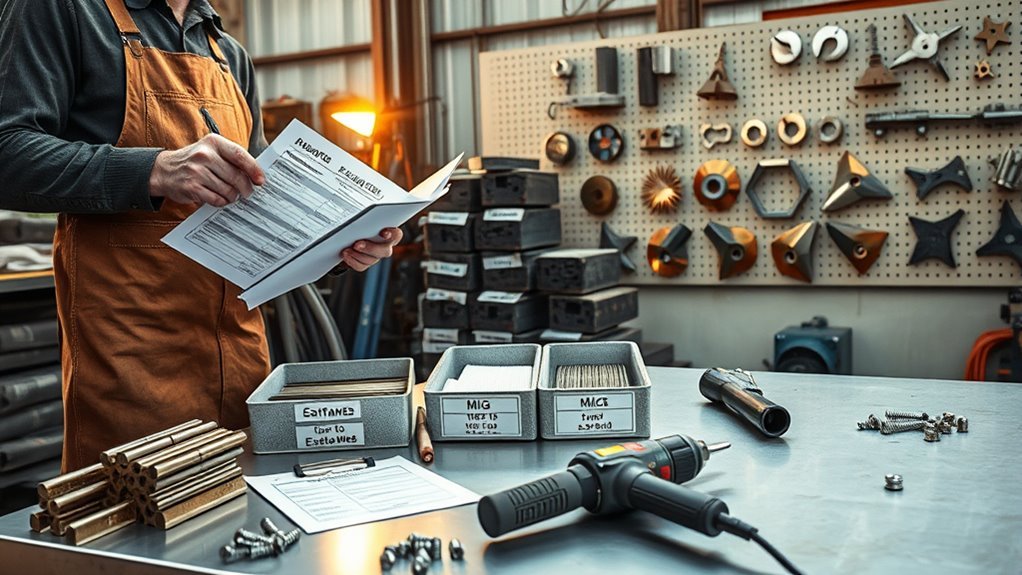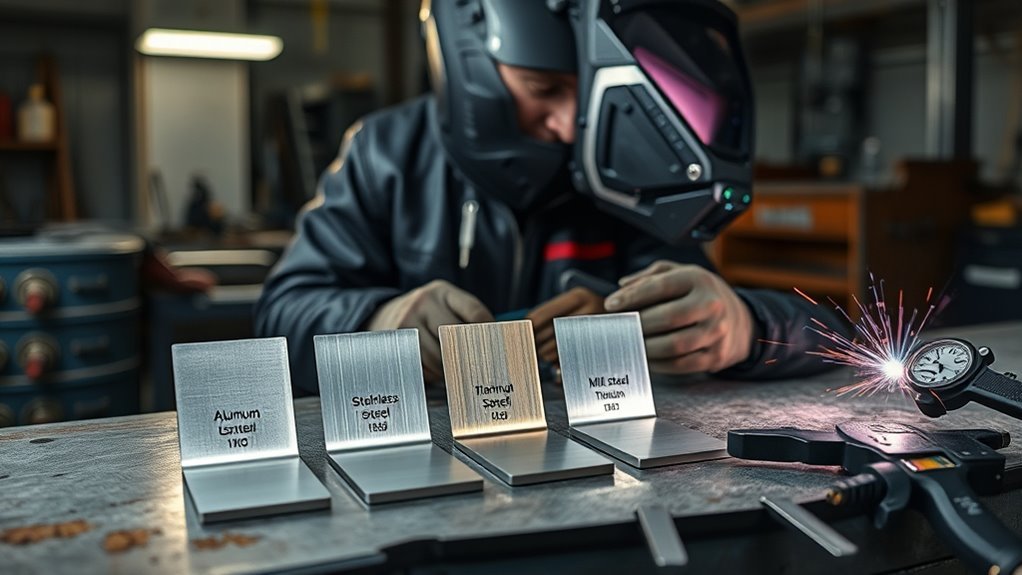You’ll typically pay about $124–$486 for a standard welding job, with hourly welder rates around $50–$125 depending on skill, location, and method. Labor is 60–70% of cost; materials and consumables add roughly 10%. MIG is cheapest for simple repairs; TIG and specialty alloys cost more. Small mobile calls often carry $75+ minimums and shop minimums run $40–$75. Keep joints clean and supply mild steel to cut costs — more specifics follow.
Typical Welding Prices and National Averages

Welding costs vary widely, but you can generally expect a national average range of about $124 to $486 per job, with a typical midpoint near $298.
You should plan estimates around that band while accounting for factors that drive variance. Project complexity dictates consumables, prep, and welding techniques required; simple patchwork uses basic MIG or stick methods, while intricate joinery demands TIG or multi-pass procedures.
Metal selection also shifts price: carbon steel remains most economical, aluminum and specialty alloys add material and labor overhead.
Expect labor to comprise roughly 60–70% of total cost, reflecting skilled time and quality control.
When budgeting, request itemized quotes that separate materials, labor hours, and technique-specific testing to guarantee standards compliance.
Welder Hourly Rates by Experience and Location

After estimating total job costs, you’ll want to break out hourly rates, since they drive roughly 60–70% of the final price and vary by experience and location.
After estimating total job costs, break out hourly rates — they drive about 60–70% of the final price.
You’ll typically see rates from $50 to $125 per hour, with a national average near $65–$90; urban markets push rates higher through geographic pricing.
If a welder holds advanced welder certifications or offers specialized skills, expect premiums—complex work can reach $150–$200 per hour.
Mobile welding often adds minimums (about $75 first hour) to cover travel and setup.
When budgeting, compare certifications, documented skill level, and local demand to select the appropriate rate band, and document scope and acceptance criteria to avoid scope creep.
Cost Breakdown: Labor, Materials, and Overhead

Because labor drives most of the final price, you should expect labor to consume roughly 60–70% of a welding project’s total cost, with hourly rates typically running $50–$125 depending on method, complexity, and location.
You should audit labor efficiency: experienced welders complete welds faster with fewer repairs, lowering hours billed.
Materials—filler metals, rods, shielding gas—generally add about 10% of total cost; aluminum and stainless raise material line-item considerably compared with mild steel.
Overhead covers equipment maintenance, shop utilities, transportation and administrative time; expect minimum service fees around $40–$75 for small jobs.
Project complexity—size, shape, accessibility, and required technique—directly increases hourly rates and material waste, so quantify complexity when estimating and reviewing market-driven material price changes.
Pricing by Welding Method (Stick, MIG, TIG, FCAW)

You’ll see clear differences in cost per hour between methods: Stick about $50–$75, MIG $65–$90, TIG $75–$125, and FCAW $55–$90.
Choose a method based on required precision and material — TIG raises labor rates for thin or high-grade metals, while Stick and FCAW are economical for thicker, structural work.
Account for material type and joint complexity when estimating total project price, since they directly alter time and consumable use.
Cost per Hour
When you’re budgeting a welding job, method choice drives hourly rates and consequently most of your total cost, since labor makes up roughly 60–70% of project expenses. You’ll weigh welding equipment capability and project timelines against hourly rates: Stick $50–$75, MIG $65–$90, TIG $75–$125, FCAW $55–$90. Choose the method that meets code, tolerances, and throughput to avoid rework.
| Method | Hourly Rate (typical) |
|---|---|
| Stick | $50–$75 |
| MIG | $65–$90 |
TIG and FCAW fall into the higher and mid ranges respectively; TIG buys precision, FCAW buys deposition speed. Estimate hours precisely to control labor-dominant costs and comply with inspection standards.
Price by Method
Having picked a welding method based on equipment capability and schedule, you’ll next look at how each process affects hourly pricing and overall budget.
Stick welding runs $50–$75/hour; it’s economical for structural work but demands strict welding safety practices and regular equipment maintenance to guarantee electrode integrity and consistent arc performance.
MIG costs $65–$90/hour, offering speed and versatility; you’ll need calibration checks and wire-feed upkeep to meet quality standards.
TIG is $75–$125/hour, the premium choice for precision and cosmetic requirements; expect higher labor skill, stringent welding safety controls, and meticulous torch and gas-system maintenance.
FCAW at $55–$90/hour suits heavy deposition rates; maintain flux handling procedures and equipment maintenance to prevent porosity and guarantee repeatable results.
Material Impact
Because material choice changes joint prep, filler selection, and travel speed, it directly shifts the effective hourly cost of each welding method.
You evaluate material selection by matching base metal and thickness to the method: Stick ($50–$75/hr) for coated or field repairs, MIG ($65–$90/hr) for versatile shop work, TIG ($75–$125/hr) for precision stainless or aluminum, FCAW ($55–$90/hr) for heavy, high-deposition tasks.
Per-inch charges also alter totals: mild steel $0.50–$2.00/in, stainless $1.00–$3.50/in, aluminum $1.25–$4.00/in.
When estimating, you factor labor rate, travel speed reductions on stainless/aluminum, filler cost, and required rework to ascertain application suitability and compliance with industry standards.
- Stick excels on dirty or painted surfaces
- MIG balances speed and finish
- TIG maximizes cosmetic and structural precision
How Metal Type Affects Welding Costs

When you budget a welding job, the metal type drives material costs and dictates which processes you’ll need—mild steel is cheapest, stainless steel costs more, and aluminum is typically the most expensive.
You’ll also face different technique requirements and labor rates (for example, TIG or specialized aluminum procedures raise hourly costs).
Finally, plan for varying preparation and finishing steps—surface cleaning, joint prep, and post-weld treatment—that add time and expense, especially on thicker or corrosion-resistant metals.
Material Cost Differences
1 clear choice you’ll make at the outset is the metal itself, because mild steel, stainless, and aluminum carry distinctly different price brackets and handling requirements that directly affect both material and labor costs.
You’ll use welding material types and a cost comparison analysis to budget precisely: mild steel commonly runs $0.50–$2.00 per inch, stainless $1.00–$3.50, aluminum $1.25–$4.00.
Steel is the baseline; aluminum and stainless typically cost 1.5–2× more and often raise labor rates due to required skill and time. Material-price volatility and part thickness further change totals, since thicker sections can force equipment upgrades and longer cycles.
- Mild steel: lowest material cost, predictable supply.
- Stainless: higher unit cost, corrosion-resistance premium.
- Aluminum: highest cost range, requires careful handling.
Welding Technique Required
Although the metal you choose sets the baseline price per inch, the required welding technique often dictates the largest share of labor costs, so plan accordingly.
You’ll see mild steel at $0.50–$2.00 per inch, stainless at $1.00–$3.50, and aluminum at $1.25–$4.00, but those ranges assume appropriate welding techniques.
Aluminum and stainless commonly require TIG or other precision processes; TIG labor runs $75–$125 per hour.
Thickness and access increase time and may force use of specialized equipment, raising hourly rates.
Filler metals add roughly 10% to total cost and specific alloys can push that higher.
Market price swings for base metals also change job estimates, so verify current material rates before committing.
Preparation and Finishing
Having picked the correct welding method for your material, you should plan preparation and finishing steps that reflect the metal’s properties and cost impact.
You’ll assess surface cleanliness, joint fit-up, and post-weld treatment because mild steel, aluminum, and stainless steel demand different actions that change time and cost.
Follow welding safety protocols during every step and document material preparation standards to avoid rework.
Aluminum needs precise oxide removal and heat control to prevent warping; stainless steel requires careful filler selection and passivation to protect corrosion resistance.
Thicker or exotic alloys increase tack and grinding time and may require higher-skilled labor.
- Clean and degrease to specified cleanliness levels for the chosen metal
- Fit-up, tack welds, and sequence to minimize distortion
- Post-weld finishing: grinding, heat treatment, passivation
Estimating Small Repairs and Mobile Welding Fees
For small repairs you’ll usually face a minimum charge—commonly $40–$75 for shop work and about $75 or more for mobile calls—to cover setup and basic labor, with MIG welding typically the cheapest option; expect total simple-repair bills to fall roughly between $124 and $486 depending on time, materials, and complexity.
You should classify repair types by scope: tack-ups, seam repairs, bracket replacements, and thin-metal patching each have predictable time and consumable profiles.
Mobile considerations include travel time, vehicle setup, and on-site gas or material surcharges; these raise the effective hourly rate.
Estimate jobs by combining minimums, measured labor hours, and explicit material charges, then adjust for local market conditions—urban competition often reduces published rates compared with rural premiums.
Ways to Save on Welding Projects
After estimating repair scope and fees, you can cut costs by shifting specific prep work to yourself—cleaning rust, removing paint, and cutting parts to size typically shave billed hours and let the welder focus on actual joining.
You should plan DIY Preparations with attention to fit, edge condition, and cleanliness so welds meet code and avoid rework.
Favor Design Simplicity: reduce joints, use continuous members, and minimize complex fixtures to lower labor and consumables.
Choose mild steel when suitable, and bring materials to avoid shop markups.
Consider mobile welders for lower overhead on small jobs.
Get multiple estimates to compare total cost, including minimum charges, so you can negotiate based on scope and provided prep.
- Cleaned, square-cut panels ready for tack welding
- Simplified bracket with single weld seam
- Mild-steel pieces supplied by you
Questions to Ask When Getting Welding Estimates
Which questions should you ask to get an apples‑to‑apples welding estimate?
Ask for the welder’s hourly rate and any minimum charge so you can compare base costs. Request a detailed quote breaking labor, materials, consumables, and additional fees to reveal the true total.
During project consultation, confirm the technician’s experience with your specific materials and required techniques; ask for references or photos of past work to verify quality.
Verify liability insurance and ask for policy limits to protect against onsite damage.
Also ask about adherence to applicable codes and welding safety practices, including PPE and inspection procedures, so the estimate reflects compliant, documented work rather than an informal rate.
Using a Welding Cost Calculator and Sample Estimates
Now that you know what questions to ask, you can use a welding cost calculator to standardize estimates and compare bids consistently.
You’ll input welder hourly rates (typically $50–$125), welding method (MIG, TIG, Stick), metal type, material inches, and complexity. The tool applies filler, overhead (10–30%), and project management assumptions to produce sample estimates; national averages fall near $298, with typical jobs $124–$486.
Use outputs to enforce welding project management standards and specify advanced welding techniques where needed.
- Example: mild steel, 10 inches at $1/inch, 2 hours at $75/hr → subtotal plus 15% overhead.
- Example: aluminum, 5 inches at $3/inch, TIG, 3 hours at $90/hr.
Compare bids using identical inputs.
Frequently Asked Questions
How Long Does a Welded Joint Typically Last With Regular Use?
A well-executed welded joint typically lasts decades under regular use; you’ll expect 20–50+ years depending on materials, joint longevity, and maintenance requirements, with scheduled inspections, corrosion protection, and load limits preserving structural integrity.
Do Welders Carry Insurance for Accidental Property Damage?
Yes—you should expect welders to carry welding liability insurance coverage; reputable contractors buy general liability and equipment policies, document limits, verify endorsements, and follow industry standards to mitigate accidental property damage and meet client requirements.
Can Welding Create Health Hazards for Nearby Occupants?
Yes — you’ll face health hazards: fume exposure can harm lungs and irritate eyes; fire risks from sparks can injure occupants or ignite materials. You should enforce ventilation, PPE, hot-work permits, and strict safety standards.
Are There Warranties or Guarantees on Welding Workmanship?
Yes — you’ll get welding warranties and workmanship guarantees; they’re the safety net guaranteeing joints meet codes, inspection criteria, and specified lifespans, and you’ll receive written terms, scope, exclusions, and corrective remedies for defects.
Do Local Permits or Codes Affect Residential Welding Jobs?
Yes — local regulations and permit costs directly affect residential welding jobs; you’ll need to confirm code requirements, obtain permits, budget for permit costs, and follow inspection standards to guarantee compliant, safe, and approved welding work.
Conclusion
When budgeting your welding project, expect national average welder rates around $50–$100 per hour, with experienced TIG welders or specialty work running higher; this gives you a concrete baseline for quotes. Know materials, method, and travel add costs, and always request written, itemized estimates. Ask about certifications, weld procedures, and inspection standards to prevent rework. With clear specs and a traceable estimate, you’ll control quality and avoid surprises.


